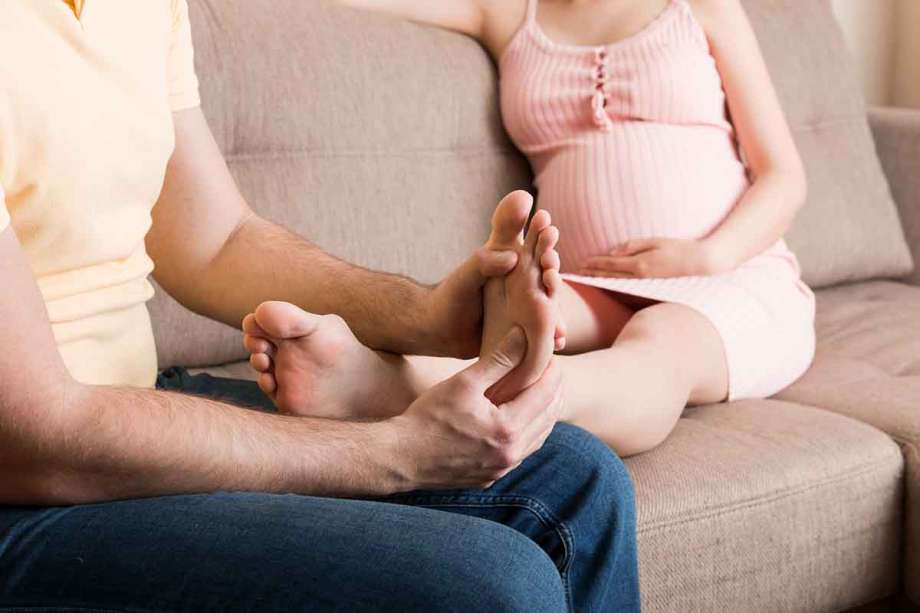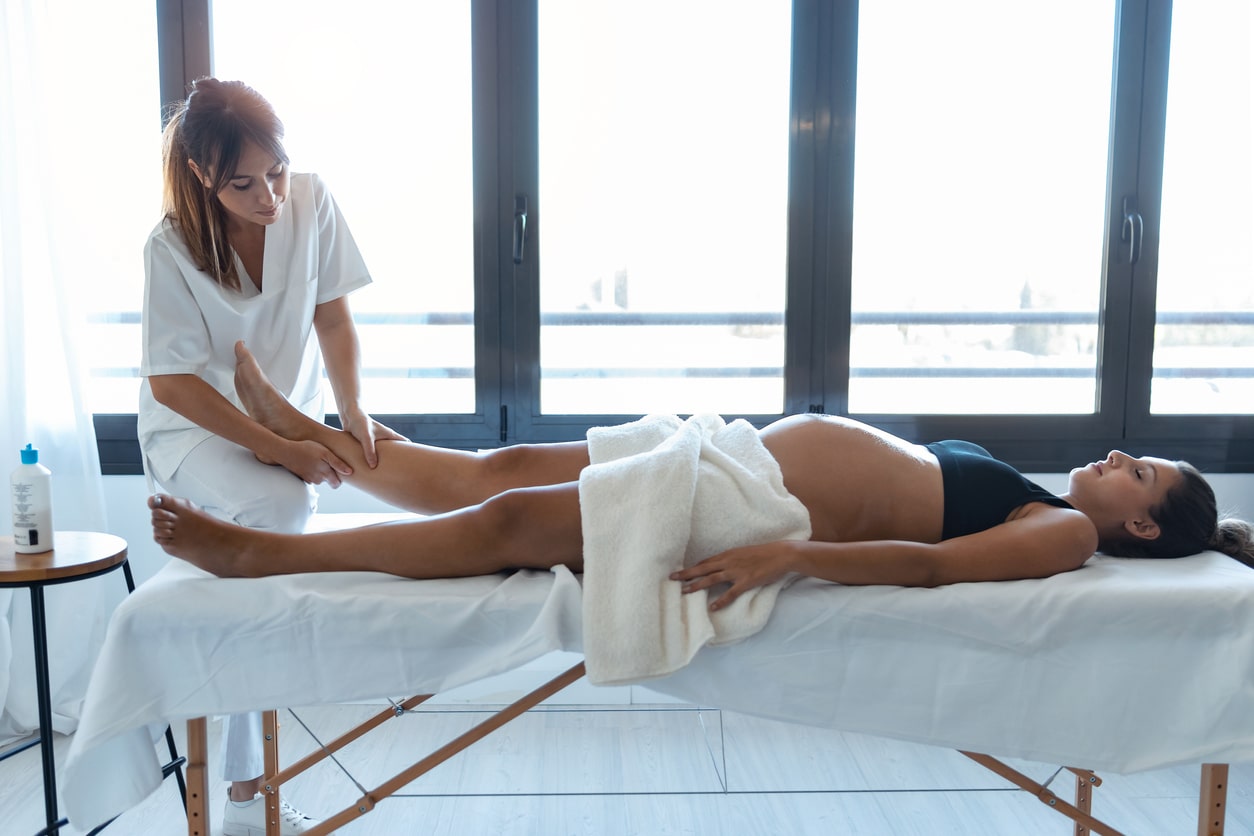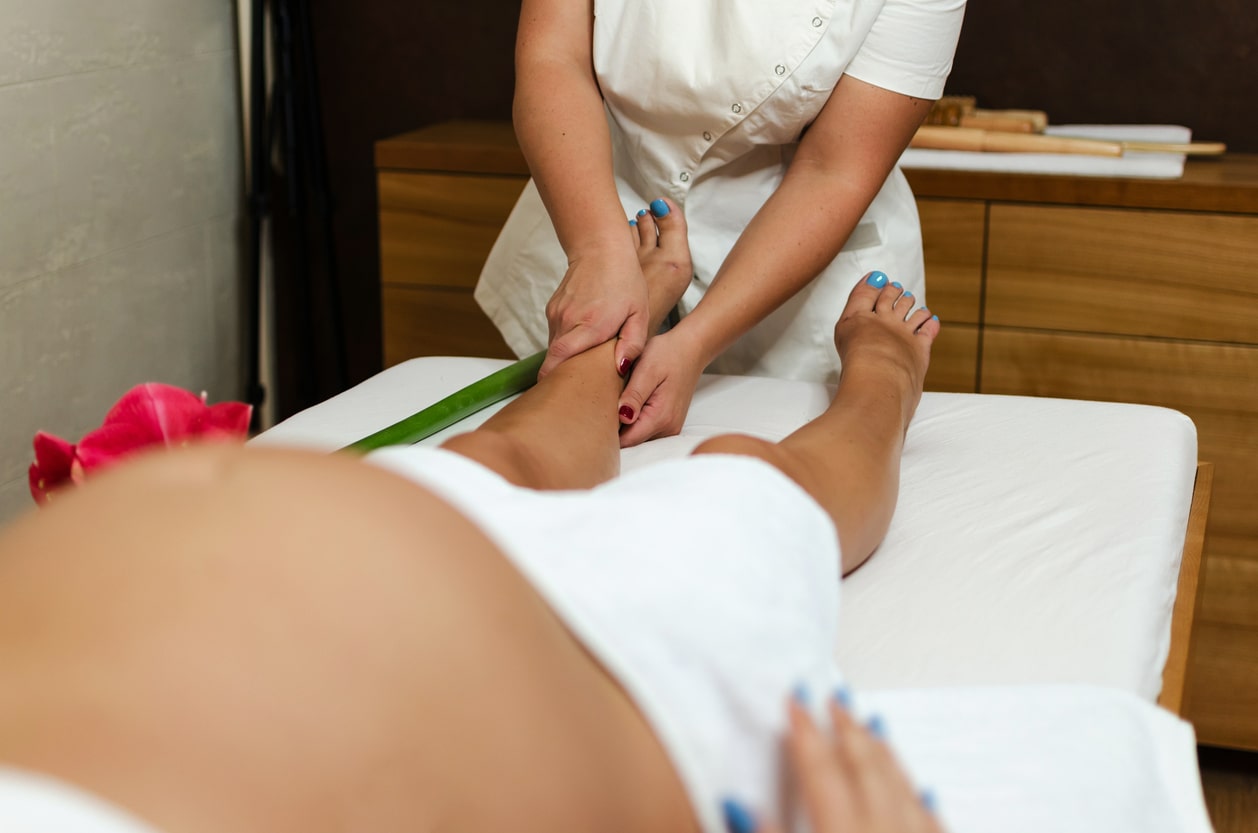Is It Safe to Have a Pregnancy Foot Massage? Pros, Cons, Techniques

When you're pregnant, it feels like everything is getting bigger, including your feet. Whether you spend a lot of time on your feet or not, you're likely to experience foot pain through various trimesters of your pregnancy — especially during the third trimester, when it's almost game time and your body is certainly feeling all the changes of the past few months!
Related: Lower Back Pain During Pregnancy
With all these aches and pains, a foot massage during pregnancy can sound like paradise. I mean, who doesn’t like to treat themselves every once in a while? But when you're expecting, it’s reasonable to wonder: Is going to the salon safe? Where does one even get a prenatal massage? Do I need special lotion or oils?
It’s true: A pregnancy foot massage is different than the one you get with a pedicure in several distinct ways, but it’s not difficult to come by. In fact, myriad massage artists now specialize in therapies structured for women who are expecting.
But before you book an appointment, it’s good to familiarize yourself with the potential risks and benefits involved with getting a foot massage during pregnancy.
Is It Safe to Get a Foot Massage During Pregnancy?
Getting a foot massage during pregnancy is an easy way to pamper yourself, but it’s also an act of self-care associated with several wellness benefits According to the American Pregnancy Association, a prenatal massage is generally safe during all trimesters.
As long as it's not too vigorous, massage therapy can help reduce muscle tension in the bottom of the foot and alleviate painful swelling in the joints during pregnancy, typically caused by lowered circulation and added pressure on blood vessels.
Rock Positano, a voluntary podiatrist at New York City’s Lenox Hill Hospital, says the three safest spots to administer a pregnancy foot massage are the heel, the arch and the forefoot. Extra care should be taken if you’re experiencing musculoskeletal issues, such as plantar fasciitis, Achilles tendonitis or neuroma.
In general, Positano suggests an even softer massage touch when you’re expecting, adding that deep massage should be avoided at all costs during pregnancy, especially around parts of the body “prone to developing blood clots due to blood change volume often accompanying pregnancy,” including the Achilles tendon, big toe and calf muscles.
If a blood clot is dislodged through a massage, he explains, it may travel to other parts of the body and cause potentially life-threatening complications for a mother and her unborn child.
Risks of Pregnancy Foot Massage and Points to Avoid

Undergoing deep tissue massages, acupressure, shiatsu or applied pressure on the lower extremities is discouraged during pregnancy, as they can cause inflammation and discomfort. In general, you’ll want to avoid any vigorous massage to protect yourself and your pregnancy.
Given the potential risks associated with a pregnancy foot massage — damage to the soft structures of the foot and/or stress fractures to the bone of the foot, due to osteoporosis or blunt trauma from a rough massage — it's best to save the job for a professional rather than your dating partner. You’ll want to schedule a session with someone who’s certified in prenatal massages: a type of massage therapy designed specifically for pregnant women.
Keep in mind, some businesses won’t perform a massage on someone who’s pregnant until after her first trimester, when the risk of miscarriage is typically less. Additionally, if you have a history of blood clots in your legs or deep vein thrombosis, your doctor likely won’t recommend a pregnancy foot massage. If your doctor does give you the green light for a “pregnant massage,” take solace in the fact that certified massage therapists will be able to consider and work around any pregnancy symptoms you might be facing, such as varicose veins or swelling.
Not sure where to go? Several national massage therapy chains offer prenatal massages these days, but don’t be afraid to consult reviews on Yelp or Google to find a therapist who will best suit you. If you’re still hesitant, give the salon a call and ask how they cater to women like you who are expecting.
Prenatal Massage Pressure Points to Induce Labor
To deliver all-over muscle relaxation, prenatal massages primarily employ Swedish massage techniques composed of gentle strokes and movements. According to Michigan-based Beaumont Health, one of these techniques is called effleurage: a type of massage that focuses on the abdomen.
“During effleurage, you use circular, rhythmic stroking movements with the palm of your hand to lightly massage your abdomen,” according to the hospital. “Focusing on the rhythm and movement will help your brain ‘forget’ the pain response, which can reduce your pain, and the massage itself can help you relax.”
A good licensed massage therapist will be knowledgeable about the anatomy of the foot, pressure points and other massaging techniques specific to pregnant women. They’ll also be aware of acupressure points to avoid that can induce labor, including:
- Spleen 6 (SP6 acupressure point): Located on the inner ankle, a massage here may stimulate the lower abdomen and bring on uterine contractions.
- Urinary Bladder 60: On the outside of the leg, between the Achilles tendon and the ankle bone, massaging this spot is believed to promote labor.
- Urinary Bladder 67: Found on the corner of the pinky toe near the toenail, massages here are said to bring on contractions.
Why Can’t You Use a Foot Spa When Pregnant?
It’s tempting to book a pedicure massage during pregnancy, as it marries the relaxation of a spa with the satisfaction of getting hard-to-reach toenails painted and trimmed. However, doctors don't usually recommend a pedicure foot massage during pregnancy, simply because they’re not typically performed by a licensed massage therapist.
Salon and at-home foot spas also pose potential health risks because of the water. A foot spa that hasn’t been properly cleaned or sanitized can breed harmful microorganisms, which can fester in water and enter your skin through cuts. According to the United States Environmental Protection Agency, “The screens and tubes of foot spas are particularly good places for bacteria to collect and grow, often forming dense layers of cells and proteins called biofilms, which can be very hard to remove.”
Additionally, you may want to avoid saunas, jacuzzis, hot tubs and steam rooms during pregnancy to prevent dehydration, fainting and overheating. As the United Kingdom’s National Health Service explains, “A significant rise in your core temperature could be harmful in pregnancy, particularly in the first 12 weeks.” When in doubt, it never hurts to consult your doctor before booking a spa service or foot massage during pregnancy.
What Are Some Benefits of a Foot Massage During Pregnancy?

A nice foot massage is a surefire way to unwind and relax. They can be both physically and emotionally therapeutic, as they feel great and force you to sit down and relax. But a pregnancy foot massage offers more benefits than just temporary relief, including:
Better Sleep
Research from the Journal of Psychosomatic Obstetrics & Gynecology links semi-regular massages to improved sleep as well as better moods and reduced back pain. Getting enough rest while expecting is crucial, as sleep deprivation during pregnancy may lead to side effects such as longer labor, added discomfort during labor and higher rates of preterm labor and cesarean section, according to the journal Sleep Medicine Reviews.
Reduced Stress and Anxiety
A superpower of massages is that they help lower cortisol levels, which in turn helps regulate your blood pressure, metabolism and stress response. According to the Mayo Clinic, a one-hour massage can help lower cortisol in your body while also releasing serotonin: a chemical that helps reduce feelings of depression, anxiety and sadness.
Improved Sense of Well-Being
A foot massage during pregnancy can leave you feeling great — and there’s science behind that. Based in the United Kingdom, the National Childbirth Trust says spa treatments such as a pregnancy foot massage may help raise your endorphins: hormones that can help boost confidence and happiness and lower pain and sadness. The Cleveland Clinic also links high levels of endorphins to reduced pain during childbirth — and who doesn’t want that?
What Is the Best Pregnancy Foot Massage Technique?
The American Pregnancy Association recommends Swedish massages during pregnancy, as they’re designed to address discomforts associated with physical changes from hormone shifts.
By applying mild pressure to targeted muscle groups — in this case, the feet — the Swedish massage helps relax muscle tension and improve lymphatic levels and circulation. This type of foot massage during pregnancy can also aid in the removal of tissue waste carried by the body’s lymphatic system, helping to prevent skin infections and other ailments.
You can also go the self-massage route. To begin, you’ll need a nice lubricant that leaves your feet feeling silky, smooth, and satisfied.
Yahoo! recommends several products for soothing and pampering your feet, including Burt's Bees Mama Bee Leg and Foot Creme ($11 at Amazon), AHAVA Dermud Intensive Foot Cream ($32 at Amazon), and Soap & Glory Pink Heel Genius Foot Cream ($11 at Ulta). Olive, jojoba, and grapeseed oil can also make for nice pregnancy foot massage lubricants.
As for how to administer the perfect foot massage during pregnancy, Minnesota-based nonprofit Allina Health suggests this step-by-step process:
- Apply a dollop of lotion or oil to your hands and rub them together. Support one foot at a time by placing one of your hands under the heel, using the other to cradle the base of your toes. Using both hands, gently rotate your toes and heel in a circle three times.
- Rest your foot on a firm surface, then place one hand flat on the top of the foot and one hand flat on the bottom. Think of your foot as a bookmark in a novel. Gently slide your hands up and down your foot, from the heel to the toes and back, three times.
- With your foot still resting on a surface, hold the foot with both hands, placing the thumbs near the ankle and the fingers under the foot. Stroke the foot gently, applying slight pressure from the thumb as you move from your ankle to your toes and back, three times.
- Hold the heel with one hand, then gently stroke the top of the foot with the other hand, using the thumb to assert gentle pressure between your ankle to your toes. Repeat three times. Still holding the heel, use your other hand to gently tug and twist each toe three times.
- Set your foot down on a firm surface, then run your fingers up and down the sides of the foot from the ankle to the toes, three times. With the foot still resting, place your fingers on top of your foot and place your thumbs underneath. Using your thumbs, rub circles into the bottom of your foot, going from the ankle to the toes, three times.
When it comes to getting a pregnancy foot massage, it's important to be aware of the risks involved. Not every woman will face the same risks, that's why it's good to talk to your doctor to see whether a foot massage during pregnancy is right for you.
Remember, taking care of yourself while pregnant can help you and your baby stay healthy trimester to trimester to delivery. Whether that means hiring a prenatal massage therapist or lathering up your feet at home, it’s always good to take time for yourself when you’re expecting. And, as always, talk to your doctor if you’re ever in doubt about what you and your growing baby need at any given time.

